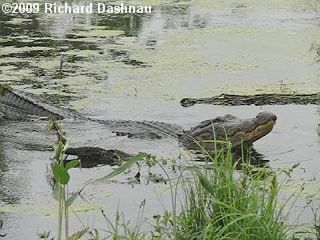 -
-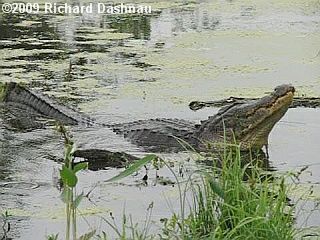 -
-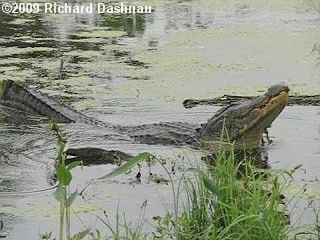 -
-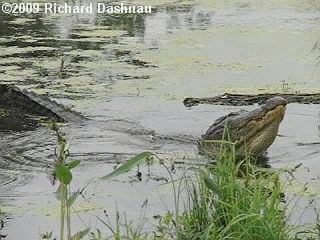
---- --INHALATION INHALATION/INFLATION-- INFLATION -- E PRE-EXHALATION/EXHALATION
Alligators,
although they are ectothermic and also equipped with a small
brain,
exhibit
a surprising diversity in their responses to their environment
and to
each
other.
They are for more complex than mere animated logs or
12-foot-long
eating machines. This
group of pages show some of what I've been able to
see in the years I've
been volunteering (September of 2001 thru March of 2020) at
Brazos Bend
State
Park.
05/17/2009--
Alligators seem to have been less active at the park during mating
season
this year. In other parts of Texas, alligator populations were reduced
by
the effects of
Hurricane Ike and the resultant salt water intrusion.
Brazos Bend State Park didn't suffer such intrusion. However, I was
finally
able to sit in on a chorus of bellows, and I was able to
record some bellows
with some high-framerate video.
In "Social Signals of Adult
American Alligators", by Leslie Garrick, Jeffrey Lang, and
Harold
Herzog (Bulletin of the American Museum of Natural History NY, 1978;
click this link
to go to
the digital AMNH library and see the pdf.) they
break down an alligator's bellow into 4 parts.
While reviewing this footage,
I've expanded this into six parts, since many different things
are
happening during the original
4 parts. This is usually repeated in a cycle of 4 or 5 bellows in a
single bout. Sometimes, there
is a single bout; but if other alligators answer, then there are
often
repeated
bouts. Here are the 6 parts
as I divided them:
1) REST
2) INHALATION--the head and the body rises, air is taken in, and the head begins to tilt up, the gular pouch extends
3) INFLATION--the head continues to tilt up; air is gulped in and throat valve closes; the body begins to sink.
4) PRE-EXHALATION--the head tilts down and the body sinks.
5) EXHALATION--the head raises, tail arches, exhalation starts
6A) VOCALIZATION A--the gular pouch inflates, back vibrates and bellow begins
6B) VOCALIZATIONb--the body sinks as the bellow fades
Return to rest position (step 1)
I
cannot capture sound while
recording the slow-motion video. Without audio one can't pick
the
various sounds during the bellow. (the gulping sound can be
pretty
distinct) that might help
identify what is going on internally. The appearance
of the bellows is still fascinating. The images below are screen
grabs
from the video.
 -
- -
- -
-
----
--INHALATION
INHALATION/INFLATION--
INFLATION
--
E PRE-EXHALATION/EXHALATION
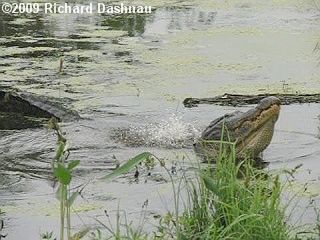 -
-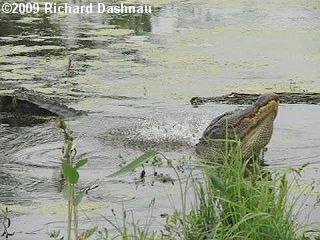 -
-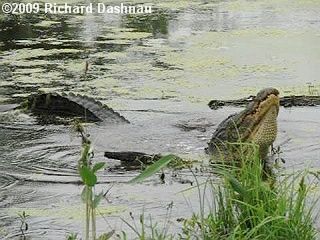
VOCALIZAION A----
--
VOCALIZATION
B
VOCALIZATION
B.
I've
edited the clips together into a single video clip. It can be seen
here
(mp4). It's worth watching, to see how the bellow's energy
travels
through the water.
4/13/2008--It's
been a while since I've seen a lot of alligator behavior in
one day.
Well, today was one of those days. First thing, I encountered the
female
alligator and her babies. This female
has been in the same area since last
August, and seems to have most of her babies. It's the same female
that
I saw on February 10th, but she's moved across the trail into
40-acre
lake.
So,
at about 9:00 a.m., I saw her with her babies. The image below
shows
them together.
---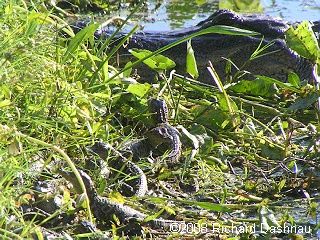 -------
-------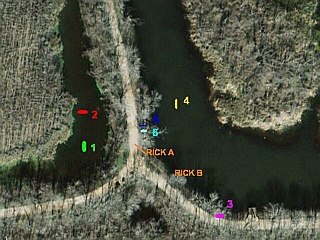 -
-
Map 1
I
made
my way to Elm Lake. The image above (Map 1) is a satellite view of
the
end of the Spillway Trail (from Google Maps). The colored numbers
on
the
image refer to the alligators I'm going
to talk about. Pilant lake
is left, Elm Lake is right.
When
I got to the water station, I saw an alligator down at the corner
in
Pilant
Lake (1) and another swimming in Elm Lake (4). When I moved
to the left
(Rick A) I saw one alligator on the trail (5) and later found
there was
another right next to it (6). I got off my bicycle. I was
talking
to a park visitor when I moved past a tree, and suddenly
saw another alligator
in the water with head and tail raised (2). This alligator did a
head
slap.
See map 2 below. Alligator 4 (yellow) just kept
swimming north.
Alligator 5 (light blue) raised its
head. Alligator 1 (green) moved
towards alligator 2 (red) and did some "snout bumping", which
probably
indicated that (green) alligator was a
female. (green)Alligator
then passed by (red)
alligator and moved north.
- -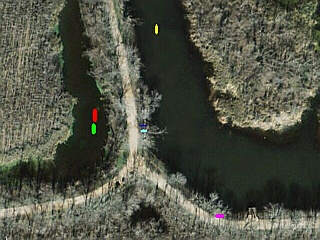 -
- 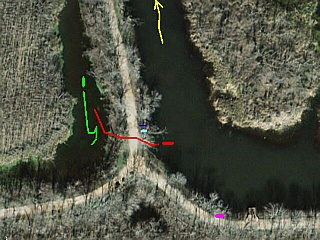 --
--
MAP
2
MAP
3
In
map
3 above: (green) alligator moved north. (yellow) alligator moved
out of
sight. (Red) turned and crossed the trail without stopping.
Sometime in
all this, another alligator 3
(purple) came onto the bank. Below are images
from the alligator crossing the trail. The first two images are
from
this
video
clip
(mp4).
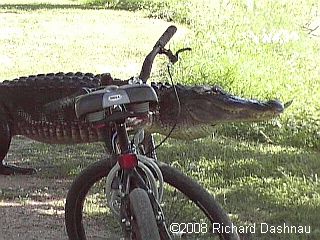 -
-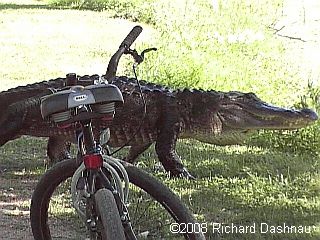 -
-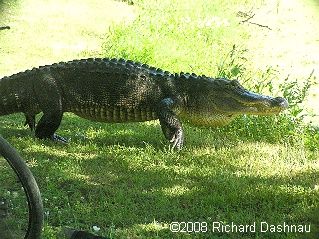 -
-
The
other images are from photos I shot at the same time. That's my
bike in
the foreground.
After
the large (red)alligator (it was about as long as the trail is
wide at
that point), it moved
towards alligator 3 (purple) on the bank, and stationed
itself about 15 feet out, facing the (purple) alligator. One
of the park
Kabodas came by towards the water station and (purple)
alligator entered
the water. Not long after, (red) alligator moved towards (purple)
alligator
and began bellowing. Meanwhile, I'd moved to "Rick
B", and began
filming and taking
photos. See map 4 below.
-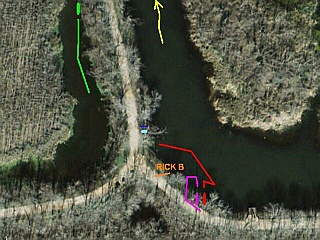 -
-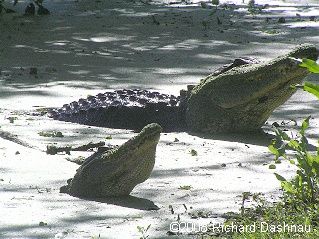 -
-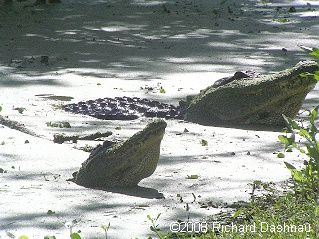
MAP 4
This
short
video
clip (mp4) shows the entire bout of bellowing. While
(red)
gator started, (purple) gator joined in. I'm very excited
about this,
because
you can hear the obvious difference
between male and female bellowing.
Some time after this, the female (purple) alligator moved back
up on
the
bank. Somewhere North, alligators bellowed out of sight.
(Red)
male turned
towards the sound, and moved quickly off to the North, towards
it. I
followed
the male and found two alligators half on the bank. The
(red)
male appeared
and began swimming toward the
larger of the two alligators. Suddenly a
female bellowed from behind me in Pilant Lake. (Red)
male
began trying
to bellow and swimming at the same time ("trying" means that
it paused
and raised its head, but sunk and swam forward). It stopped at
a branch
and did a single growl. After some time, it moved slowly
towards the
two
alligators on the bank. It finally got on the
other side of the smaller
one (which I assumed was female). (Red) male was half on
the
bank. Then,
about 5 feet South was the smaller one (about 7 feet long),
and about 5
feet further
South was the other large one (presumably male). After a
bit
more time, the other male (not Red) slid off the bank, and
slowly swam
away.
Later,
at about 1:00pm, I was back near the
baby
alligators. After a few attempts
at counting, the best I could do was count "more than 17". The
female
stayed close to the babies, even occasionally sliding up
near
them, or even
through
clumps of them. The last images are of some of the
babies on
the
mother alligator. Occasionally, one of the babies would
seem
to tug at
something on the mother alligator--on her
skin or something on the skin.
I couldn't see what there was.
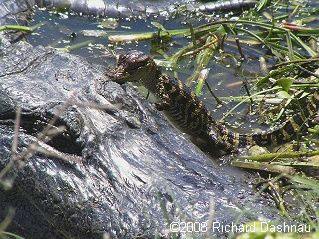 -
-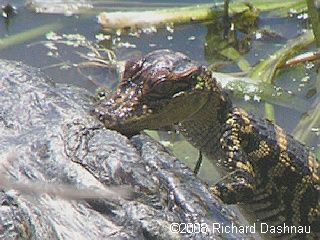 -
-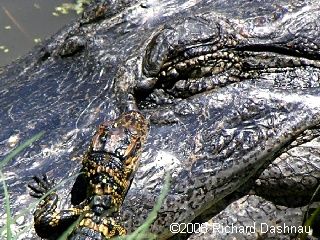 -
-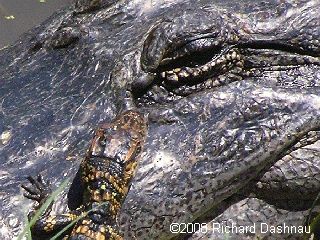
MOM! YOU AWAKE?
YEAH,
WHAT
IS IT, KID?
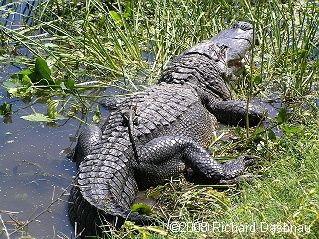
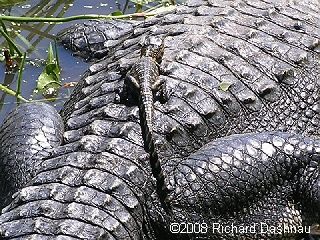
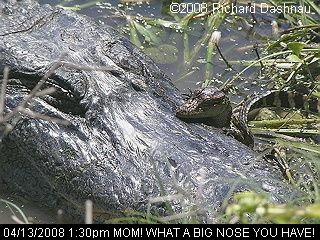
And, this page shows alligators at the park, on land, near various landmarks at the park.
Go back to my main alligator page, Alligators
Go
back to my home page, Welcome
to rickubis.com
Go
back to the See
the World
page.